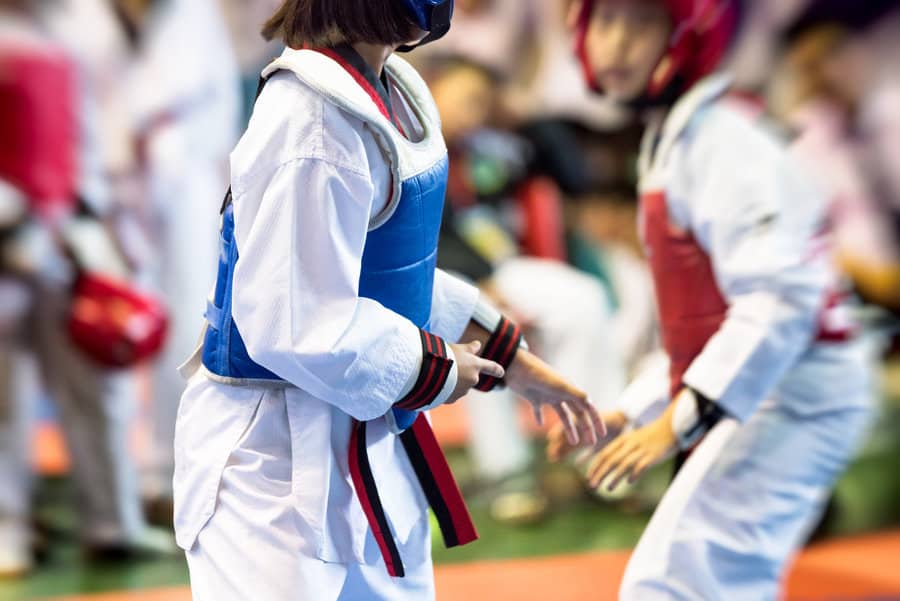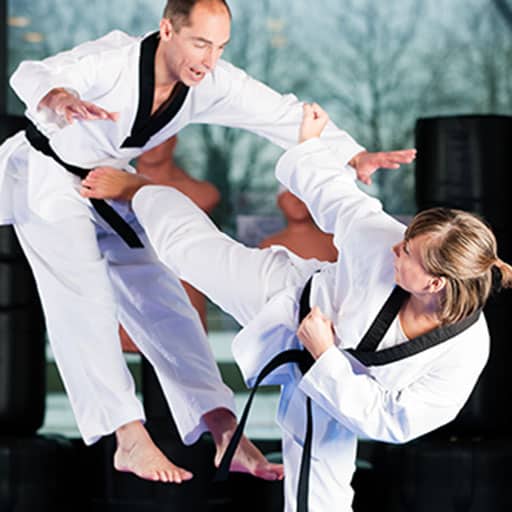
Sparring is one of the most exhilarating aspects of Tae Kwon Do training. It provides the opportunity to put techniques into action, testing how well kicks and punches work in dynamic combat situations. However, I found mEverything You Need to Know About Taekwondo Sparring
Sparring is hands-down one of the most exciting parts of Taekwondo training. It’s where you get to put your kicks, punches, and blocks to the test in a fast-paced, real-time setting. I used to fall into the trap of repeating the same moves over and over during sparring, which got predictable fast.
After digging into advice from seasoned fighters, I learned that sparring isn’t just about throwing techniques—it’s about strategy, timing, and staying sharp. Here’s a complete guide to Taekwondo sparring, covering techniques, rules, and tips to level up your game.
What Is Taekwondo Sparring?

Sparring in Taekwondo is where the action happens—you get to test your skills against another person in a safe, controlled setting. It’s not just about landing kicks or punches; it’s a mental and physical challenge that pushes you to think fast and move faster. Whether you’re new to the dojang or aiming for a tournament, understanding what sparring is all about sets you up to grow as a fighter.
In Taekwondo, sparring is a controlled combat practice where two fighters face off, using kicks, punches, and blocks to score points or outmaneuver each other. The World Taekwondo (WT) calls it kyorugi, while the International Taekwon-Do Federation (ITF) calls it matsogi. Despite the different names, both focus on safe, competitive exchanges with clear rules and protective gear.
Sparring teaches you to manage your energy—when to attack, when to defend, and when to catch your breath. Without pacing yourself, even the best fighters burn out mid-match. Whether you’re training for fun, self-defense, or competition, sparring builds confidence and sharpens your skills in a way that drills alone can’t.
How Sparring Works: WT vs. ITF Rules
Taekwondo sparring looks different depending on whether you’re following World Taekwondo (WT) or International Taekwon-Do Federation (ITF) rules. WT is the high-energy, full-contact style you see in the Olympics, while ITF focuses on precision with lighter contact. Knowing the differences in scoring, gear, and match setup helps you prep for the kind of fight you’re stepping into.
WT and ITF have distinct approaches to sparring, especially in competitions. WT sparring is full-contact, fast-paced, and kick-focused, while ITF is semi-contact, emphasizing precision and control, with more hand techniques allowed. Here’s how they compare:
| Aspect | World Taekwondo (WT) | International Taekwon-Do Federation (ITF) |
|---|---|---|
| Contact Level | Full-contact | Semi-contact (light contact, excessive force penalized) |
| Scoring Area | Punches to trunk only; kicks to trunk and head | Hand and foot attacks to head and body allowed |
| Scoring System | Electronic (1–5 points based on technique) | Continuous points (1–3 points based on target) |
| Protective Gear | Hogu (chest protector), helmet, shin/arm guards, groin guard | Optional headgear, lighter padding, hand/foot guards |
| Match Format | 3 rounds, 2 minutes each, 1-minute rest | 2 rounds, 2 minutes each, 1-minute rest |
| Ring Size | 8m octagon | 9m x 9m square (no ropes) |
WT Scoring
In WT competitions, points are awarded based on the technique and target, often using electronic scoring systems for accuracy:
- Punch to trunk: 1 point
- Kick to trunk: 2 points
- Turning kick to trunk: 4 points
- Kick to head: 3 points
- Turning kick to head: 5 points
WT updated its rules in 2016 (effective 2017) to reward aggressive, high-scoring kicks and reduce stoppages, making matches more dynamic. Punches to the head are off-limits to prioritize safety.
ITF Scoring
ITF uses a continuous point system, where fighters keep going after scoring. Points vary by organization, but a common example (e.g., TAGB rules) is:
- Punch to head or body: 1 point
- Kick to body: 2 points
- Kick to head: 3 points
Hand attacks to the head are allowed, but excessive contact leads to warnings or disqualification.
Gear and Safety
WT fighters wear a hogu (chest protector), helmet, shin and arm guards, and a groin guard to handle full-contact impacts. ITF sparring, being semi-contact, uses lighter gear—hand and foot pads are mandatory, but headgear is optional in some cases. Both require a dobok (uniform) and follow strict safety protocols to keep things fair and injury-free.
Types of Sparring
Sparring isn’t one-size-fits-all in Taekwondo. From competitive matches with electronic scoring to pre-arranged drills for beginners, there’s a range of formats to suit different goals. Each type hones specific skills, whether you’re working on speed, control, or self-defense. Here’s a breakdown of the main types you’ll encounter.
Beyond competitive sparring, Taekwondo includes other formats:
- Point Sparring: Light contact, stopping after each point is scored. Common in beginner or junior matches.
- Step Sparring: Pre-arranged exchanges (e.g., one-step, two-step, three-step sparring in ITF) to practice specific techniques. Great for learning control and timing.
- Non-Competitive Sparring: Freeform practice in the dojang to test techniques without scoring, often used for self-defense training.
Each type builds different skills, from precision in step sparring to endurance in competitive matches.
Top Sparring Strategies
Good sparring is about outsmarting your opponent, not just outkicking them. The best fighters combine sharp observation, smart movement, and reliable techniques to stay one step ahead. These strategies will help you spar smarter, whether you’re facing a friend in practice or a rival in competition.
Figure Out Your Opponent
Watch how your opponent moves. Do they favor a certain kick? Are they aggressive or defensive? Try a fake move—like a half-step forward or a shoulder twitch—to see how they react. For example, if they always throw a roundhouse kick when you step in, you can sidestep and counter with a back kick. Focus on their body, not their eyes, since good fighters hide their plans.
Move Smart
Beginners often back up when attacked, which makes them predictable. Instead, move side to side. If your opponent throws a back kick, step to their open side (where they’re not facing) and hit with a roundhouse or turning kick. This throws off their balance and sets you up to score. Sidestepping also works against spinning kicks, letting you use their momentum against them.
Stick to Simple Techniques
Forget the fancy stuff you see in movies. Basic kicks like the roundhouse, axe kick, and back kick are your bread and butter. They’re fast, reliable, and work for both attack and defense. For example, if someone throws a roundhouse, block it and fire back with a quick axe kick to their chest. Practice these until they’re second nature—precision beats flashiness every time.
Master Counterattacks
Counterattacking is about timing. Instead of always attacking first, wait for your opponent to make a move. There are two types:
- Direct Counter: You both strike at once, and the faster one scores. Risky but quick.
- Indirect Counter: Block or dodge, then strike while they’re recovering. This is safer and lets you set up a follow-up.
For example, if they throw a roundhouse, step back, block, and counter with a side kick to their trunk. Indirect counters give you control and keep your opponent guessing.
Use Combinations
Single kicks are easy to predict. Stringing techniques together keeps your opponent on their toes. Try these combos:
- Roundhouse kick → Axe kick
- Back kick → Turning kick
- Double roundhouse → Side kick
Practice these in front of a mirror or with a partner to build muscle memory. Time yourself doing as many combos as possible in 30 seconds to boost speed.
Sparring Multiple Opponents
Facing more than one opponent changes the game. You can’t trade blows like in one-on-one. Instead, use deception—fake a kick at one person, then hit another. For example, pretend to roundhouse one opponent, but spin into a back kick for the other. Stay moving to avoid getting cornered, and position yourself so opponents block each other’s paths. It’s about staying sharp and unpredictable.
Training Tips to Improve
Getting better at sparring takes more than just showing up to class. It’s about building habits that sharpen your reflexes, boost your stamina, and fix your weaknesses. These practical tips will guide you to train effectively and see real progress in the dojang.
- Shadow Sparring: Practice movements alone, imagining an opponent. Focus on footwork and combos.
- Partner Drills: Work with a training partner to practice counters and combos at half-speed, then full-speed.
- Conditioning: Build stamina with cardio (running, jump rope) and strength training (squats, core work). Sparring is exhausting, and fitness makes a difference.
- Review Matches: Watch your sparring sessions or pro matches on YouTube (try “TKD Coach Academy” for ITF breakdowns). Note what works and what doesn’t.
Sparring often exposes weaknesses, like slow footwork or predictable kicks. Train those weak spots in a safe setting to see steady progress.
Facing Tough Opponents
Every sparring match throws something new at you—a faster kicker, a stronger striker, or a craftier strategist. Learning to adapt to tough opponents builds your confidence and skills. This section shares ways to stay cool and hold your own, no matter who’s across the mat.
Every sparring session teaches you something, whether you’re up against a faster, stronger, or more experienced fighter. Adaptability is key. If they’re taller, stay close to limit their kicking range. If they’re faster, focus on counters to catch them off-guard. Keep calm, stick to your game plan, and learn from each exchange.
Final Thoughts
Sparring is the heart of Taekwondo’s challenge and reward. It’s where you learn about yourself as a fighter and grow through every kick, block, and counter. These closing tips sum up how to keep improving and make the most of every sparring session.
Sparring is a skill that grows with time and effort. It’s not just about landing kicks—it’s about outthinking your opponent, staying composed, and building endurance. The more you spar, the more you learn about timing, positioning, and strategy. Find a training partner, focus on your weaknesses, and keep showing up to the dojang. With practice, you’ll turn from a beginner into a confident, skilled fighter.

